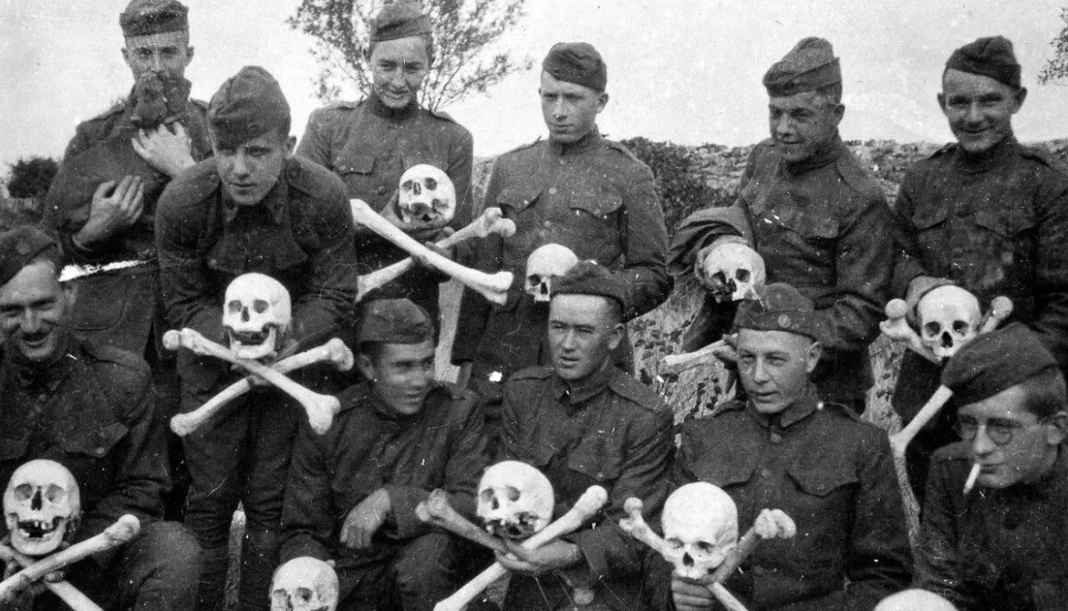In the dark labyrinth of the Kennedy administration, where mystery masquerades as truth, the name Skull & Bones finds its way into the conversation far too often. Welcome, fellow seekers of truth, to the most devastating exposé of the postwar era – a tale wrapped in secrecy, sprinkled with power, and doused in the blood of American soldiers.
Ride with me on the tumultuous waves of history as we expose how Skull & Bones, an enigmatic secret fraternity, masterminded America’s disastrous foray into Vietnam. This is not for the faint-hearted. This, my friends, is the naked truth of the “Bonesmen’s Debacle.“
Take a moment to savor the incisive wisdom of David Halberstam, who argued in his best-seller, “The Best and the Brightest,” that the JFK presidency marked the zenith of Skull & Bones’ influence, an influence that plunged the United States into a tailspin of decline.

We’re diving deep into the vortex of power that swirled around Skull & Bones elder statesman Robert Lovett, who personally crafted JFK’s Cabinet. Lovett’s masterstroke was to populate critical posts with Bonesmen, including McGeorge Bundy as National Security Adviser and Averell Harriman as Under Secretary of State for Asian Affairs.
In contrast to the chilling wisdom of Gen. Douglas MacArthur, who cautioned against ground wars in Asia, these Bonesmen thrust America deeper into the quagmire of Vietnam.
Conspiracy, you ask?
It’s all there in the annals of history.
Following JFK’s assassination, an avalanche of American soldiers descended into Southeast Asia. To keep up appearances, Harriman continued to influence Vietnam policy under President Lyndon Baines Johnson, while Bundy maintained his stranglehold as National Security Adviser.
Let’s dig deeper, shall we?
In an insidious twist of irony, Bundy, now at the helm of the Ford Foundation, funneled financial support into the anti-Vietnam War movement. Picture this: leading Bonesmen instigating the cataclysmic war strategy while simultaneously nurturing the counterculture that sought to undermine it.
Could anything be more damning?
In the aftermath of this epic failure, the Skull & Bones powerhouse lost its unchallenged grip on power. The Nixon administration saw the rise of Henry A. Kissinger, an ally of the British Foreign Office, marking a decline in the Bonesmen’s governmental sway.

But their lust for power remained unsatiated. They attempted a comeback when Gerald Ford became president. Kissinger was ousted as NSC Adviser, replaced by Gen. Brent Scowcroft, and the CIA was handed to George Bush, a fellow Bonesman. But alas, the plan was foiled with the election of Jimmy Carter, leaving Skull & Bones languishing in obscurity until the inauguration of George Bush as president in 1989.
During the interlude, the U.S. economy was subjected to disastrous policies, some spearheaded by Bonesmen like Bundy and Harriman, which saw a period of scientific, technological, and industrial regression. The country spiraled from being the largest creditor nation to the biggest debtor nation, as the dollar was divorced from a fixed, gold-backed exchange rate system.

As the dust settled on this cataclysm, a new power emerged: the Zionist lobby, wielding considerable influence in Congress, Hollywood, and Wall Street. Here, Henry Kissinger’s prominence in the Nixon administration testified to the Zionists’ significant incursion into power corridors.
The rise of East European Ashkenazic Jews on Wall Street, known as the “New Crowd,” intensified the brewing tension with the WASP establishment, leading to a resurgence of antisemitism among the Bonesmen.
The “Bonesmen’s Debacle” in Vietnam was more than a mere military disaster. It was a seismic shift in American power dynamics, revealing the secret fraternity’s lethal game of chess that led to a tragic loss of life.
It’s a history lesson on power, secrecy, and the high price of clandestine manipulation.
Buckle up, for the truth is a bitter pill to swallow.





